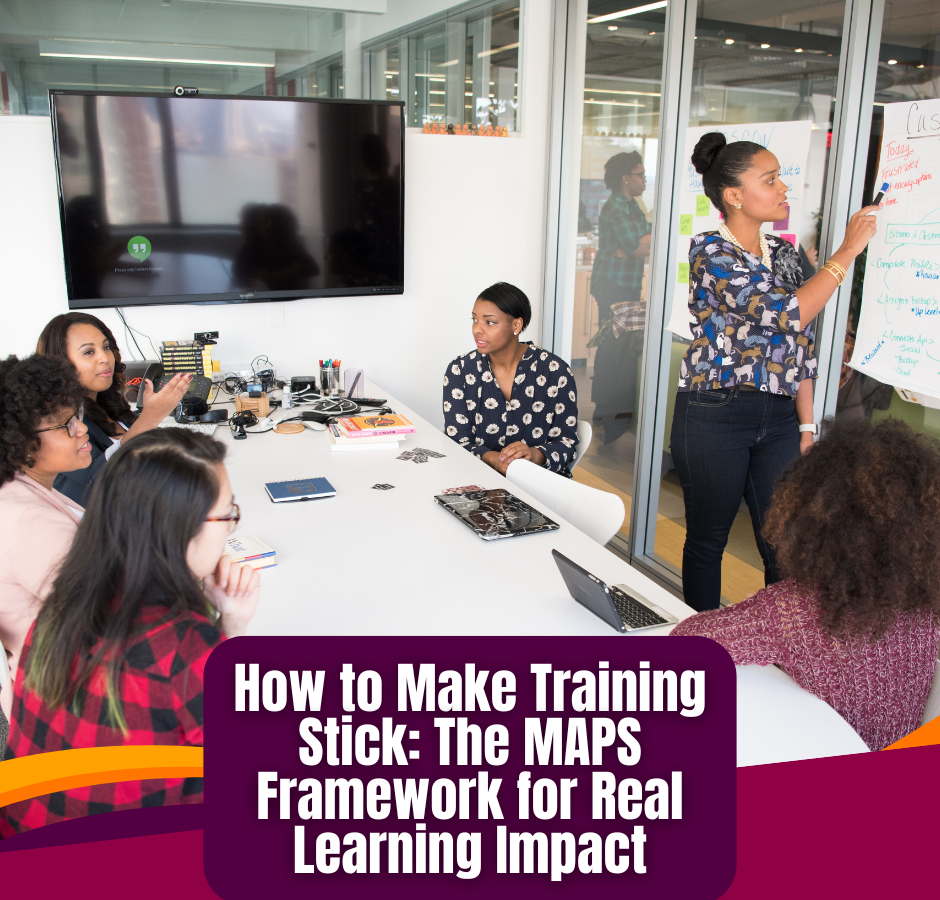Why Most Corporate Training Fails—And How to Fix It
Each year, organizations invest billions in training programs, yet many struggle to see meaningful results. Despite good intentions, corporate training often falls short of its goals.
- Employees forget 70 percent of what they learn within 24 hours.
- Less than 20 percent of employees apply new skills on the job.
- HR and L&D leaders struggle to prove ROI, making it difficult to secure continued leadership support.
The result? Training becomes a cost center rather than a strategic driver of business performance.
However, these challenges are not due to a lack of effort. The real issue lies in how training is designed, delivered, and measured.
The good news? There’s a fix.

Why Training Fails—And What Most Organizations Overlook
1. Training is disconnected from business goals
Many training programs exist in isolation, with no clear link to business objectives. Employees attend sessions that feel generic, outdated, or irrelevant to their daily work. Without alignment to real performance needs, training becomes a box to check rather than a tool for growth.
🔹 In the webinar, I’ll walk through a simple framework to ensure training directly supports business goals—and show you how one company reduced time-to-productivity by 30 percent with this approach.
2. Training lacks engagement and real-world application
Most training is too passive. Employees sit through long, lecture-style sessions filled with slides and theories, but without real-world scenarios and interactive elements, retention suffers.
🔹 One small shift can instantly improve training engagement and retention. I’ll show you exactly how to apply this to your training programs in the Executive Professional Development Session. REGISTER HERE
3. No system for measuring training impact
Many organizations track attendance and completion rates—but these metrics don’t prove whether training actually works. If employees aren’t applying what they learn, how can its effectiveness be measured?
🔹 There’s a proven system to measure training impact beyond completion rates. I’ll walk you through how to apply it—even if you don’t have advanced tracking tools.
How to Make Training Stick: The MAPS Framework
If your organization struggles to make training effective, you are not alone. That is why I am hosting a free Lunch & Learn webinar to break down the MAPS Framework—a structured system that ensures training is engaging, practical, and measurable.
During this one-hour session, I’ll cover:
✔️ Why most training fails—and the one strategy that instantly improves retention
✔️ How to create interactive, scenario-based training that employees actually apply
✔️ A step-by-step walkthrough of my MAPS Framework (not shared in this article)
✔️ Real-world case studies showing how organizations fixed their training gaps
Executive Professional Development Session Details
📅 Date: Thursday, March 13
⏰ Time: Noon EST
📍 Location: Virtual (Zoom Live)
🎯 Who Should Attend? HR and L&D professionals, corporate trainers, and business leaders who want training programs that drive real results.
Bonus for Attendees: Everyone who joins the session will receive a Training Effectiveness Checklist to apply these strategies immediately.
These insights are just the beginning. Join me for this live session where I’ll walk through actionable strategies that will help your organization fix training gaps and drive real impact.
I look forward to seeing you there!

For Corporate Trainers: Scale Your Impact Beyond Live Workshops
Many corporate facilitators find themselves caught in a cycle of one-off training sessions, constantly chasing the next client while trying to maintain a steady income. But what if you could turn your expertise into a scalable asset—one that companies pay for repeatedly, even when you’re not in the room?
If you’ve ever thought:
- “I love facilitating, but I want a way to generate consistent income from my training.”
- “I know companies need my content, but I don’t know how to package it for scale.”
- “How can I move beyond delivering the same live workshop over and over?”
It’s time to shift from a time-for-money model to one that allows you to leverage your expertise at scale.
The Problem: One-and-Done Training Doesn’t Scale
When corporate trainers rely solely on live workshops, they face three major challenges:
🚫 Limited Income Potential – You can only deliver so many sessions, and your revenue is directly tied to your availability.
🚫 No Long-Term Client Retention – Once a company completes your workshop, there’s no built-in reason for them to keep paying you.
🚫 Difficulty in Reaching Larger Audiences – Your impact is limited to the number of employees you can train in a single session.
The good news? There are proven ways to scale your training beyond live workshops—without giving up facilitation altogether.
The Solution: Three Ways to Scale Beyond Live Training
🔹 1. License Your Training to Companies Instead of delivering the same session repeatedly, create a structured program that companies can license and deliver internally.
✅ Package your training as a corporate learning asset that companies pay for annually.
✅ Offer customization options so organizations can tailor it to their teams.
✅ Sell one training, multiple times—increasing revenue without increasing effort.
💡 Example: A leadership coach who previously ran live workshops now licenses a six-module digital leadership course to companies for $25,000 per year.
🔹 2. Convert Your Training Into a Corporate Course Companies want flexibility in how their employees access training. By converting your workshop into a SCORM-compliant online course, you allow organizations to integrate your content into their Learning Management Systems (LMS)—meaning they can train employees on-demand.
✅ Make your content available 24/7 without needing to be present.
✅ Upsell companies on annual content updates for continuous revenue.
✅ Attract larger clients who require scalable training solutions.
💡 Example: A diversity and inclusion facilitator transformed her in-person workshop into an on-demand DEI training series, which now generates passive income from multiple corporate clients.
🔹 3. Offer Retainer-Based Corporate Training Partnerships Rather than selling one-off workshops, position yourself as a long-term training partner through a retainer model.
✅ Offer quarterly training refreshers, coaching sessions, or content updates as part of an annual agreement.
✅ Position your expertise as a continuous learning resource rather than a single event.
✅ Secure predictable, recurring revenue instead of constantly hunting for new contracts.
💡 Example: A communication skills facilitator shifted from single-session workshops to a 12-month corporate coaching agreement, securing a $60,000 annual contract instead of a $5,000 one-time training.
Where Do You Start? Let’s Build Your Scalable Training Model
If you’re ready to stop trading time for money and turn your facilitation expertise into a scalable, high-value corporate training business, I’d love to help.
📩 DM me “SCALE” and I’ll send you a strategy guide on how to package, license, and sell your training to companies.
The future of corporate training isn’t just in delivering sessions—it’s in owning valuable training assets that companies invest in long-term. Let’s build yours.
